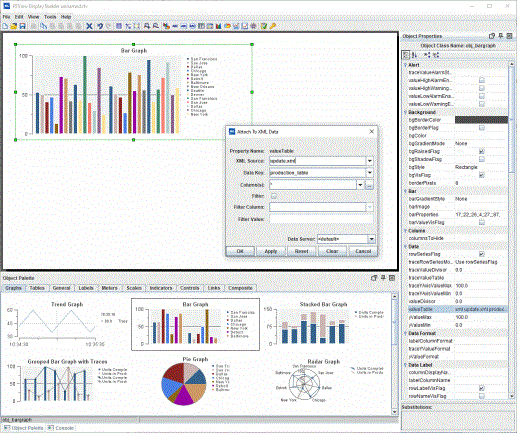| CHAPTER 5 | Building Displays |
With the Display Builder you can quickly create flexible, customized dashboards, animated by your data, that provide at-a-glance access to critical business operation data. Using a point-and-click palette, select from a variety of graphic objects and attach them to live and archived RTView Data Sources.
Note: You may not be licensed to run all RTView data sources. Choose from a wide selection of meters, gauges, tables, graphs and scales. Once you have configured your display, you can run it in the Display Viewer as a stand-alone Java application.

|
Working Area |
Located in the upper-left portion of the Display Builder, the Working Area enables you to quickly build customized displays with objects that connect easily to live and archived data. |
|
Object Properties Window |
Located on the right side of the Display Builder, the Object Properties window lists available attributes of the selected object and lets you edit property values. |
|
Object Palette |
Located just below the Working Area, the Object Palette features point-and-click access to graphic objects. Refer to the Using the Object Palette section for details. |
|
Console |
Located just below the Object Palette, select the Console tab to view error messages and debug information as you develop your display. By default, timestamps are displayed in the Console window. Refer to Setup>RTV_JAVAOPTS for details on how to disable timestamps. |
|
Toolbar |
Located above the Working Area, the Toolbar gives you access to a wide variety of objects and functions. |
This section includes the following:
| • | Builder Options |
| • | Running the Display Builder |
| • | Using the Object Palette |
| • | Style Sheets |
| • | Drill Down Displays |
| • | Drill Down Column Substitutions Dialog |
| • | Attach to Data |
| • | Define/Execute Command |
| • | File Options |
| • | Background Properties |
| • | View Options |
| • | Multiple Display Panels |
| • | Include Display Files |